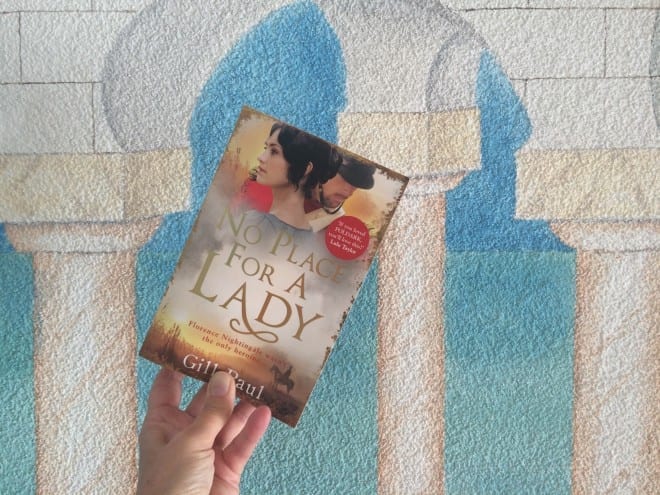Talking Location With … author Tom Benjamin: BOLOGNA and environs
Novel set in the Turkish Territories (Turkey during the Crimean War)
6th October 2015
No Place for a Lady by Gill Paul, set in the Turkish Territories (Turkey).
(Click on the photo to buy your copy or check out your nearest bookshop!)
A captivating book that blends personal relationships with the horrors of the war in Crimea in the 1850s.
I came across Gill’s work when I read The Affair set in Rome which builds the story behind the Burton-Taylor burgeoning romance in the 1960s. Such a readable style that vividly evokes the period, and again in this book Gill has achieved a carefully crafted story of human encounters and endurance in a well researched historical setting.
Lucy is a headstrong young woman who determines to marry Lucky Charlie so that she can accompany him to the battle front in Crimea. This for me was a first, that women could accompany their husbands and live in the camps from which the military offensives were planned and executed. A really astounding fact.
In order to do this, Lucy estranges herself from her sister Dorothea, who feels that she is far too young to know her own mind and really understand her impulse for marriage. And off she sails with her husband to the front. There are other army wives who take her under her wing and show her the ropes, but it is nevertheless a life unimaginable in the staid sitting rooms of Russell Square in London of the mid 19th century, let alone present day.
As the war builds up, the conditions deteriorate and the fear for everyone in the camps becomes overwhelming. It truly is a “godforsaken war”, The lack of support and resources for the armed forces is quite shocking and even under the auspices of Florence Nightingale, the troops are losing their numbers in droves. But resourcefulness is the hallmark of those over there, from soaking blisters in strong tea, or using arrowroot mixed with alcohol to lighten the mood of the terminally wounded, right down to a prolific use of mustard in the care of wounds and afflictions. And imagine the phenomenon of the “lady tourists” who shipped themselves out to the area to view the battle sites…
Meanwhile back in London Dorothea sorely regrets the terms on which Lucy left and as a nurse is determined to go and support the war effort and try and locate her sister.
This is an effortless read, that captures the feel of a raging and ill-planned war, and the mores of society of the mid 19th century and although the way in which Lucy’s life pans out might feel a touch fanciful, it is engrossing. Recommended.
Tina for the TripFiction Team
Over to Gill who chats to us about writing and inspiration….
TF: You chose to set No Place for a Lady in the Turkish Territories during the Crimean War of the 1850s. What drew you to this period in history.
GP: It was an extraordinary time for women, when for the first time middle-class girls were able to have careers outside the home. My heroines, Dorothea and Lucy, like many of their generation, were brought up in a very restricted Jane-Austen-style society and found themselves hopelessly out of their depth in a foreign war, so that contrast makes a good starting point for a story. I’m also fascinated by the huge leaps forward in medicine around that time, with the development of professional nursing, the discovery of the cause of cholera, the use of anaesthesia in surgery, and the realization that patients were more likely to survive if you kept the wards clean!
TF: Many of the characters existed in real life, Mrs Seacole, Lord Raglan. You also include the Lady Tourists, which is a very strange phenomenon (women who toured the battle sites); and the fact that military wives were allowed, indeed encouraged, to accompany their husbands to the war zone. Such a fascinating picture of the era – how did you carry out your researches?
GP: I was helped by the fact that many of the real-life characters I include in the novel had written memoirs about their time in the Crimea: Mary Seacole, Fanny Duberly and Elizabeth Davis all wrote their own books, as did a wonderful nurse called Sarah Anne Terrot and a surgeon called George Lawson. Lord Raglan, Florence Nightingale and W.H. Russell each have multiple biographers, but I prefer to go back to the horse’s mouth if I can. I’m afraid I shamelessly borrowed some descriptions from the memoirs of those who were there: the rats glistening with fleas, the stench of the wounds – all these are in their own words.
TF: Florence Nightingale also plays a part in the story. She is portrayed as having a very determined character, at times quite hard-line and inflexible – what was your impression of her from your researches?
GP: I wasn’t sure I was going to like Florence when I started researching, but I grew to be a huge fan. She single-handedly advanced the cause of women by light years! Since finishing the novel I’ve written a short story about the personal sacrifices she made to fulfill her ambitions. After the War, she had very poor health as a result as an infection she caught in Crimea, but she went on to establish nationwide training schools for nurses, and to lead government policy on a wide range of health-related issues. No doubt it was unpleasant if you caught the sharp edge of her tongue, but I’d have forgiven her anything.
TF: What are you working on now, and will location be important? And what era will you choose?
GP: My next novel is about the Romanov royal family who were executed in Russia in 1918. The locations are crucial, and I’m on a fast-track learning curve about the very different types of geography in that vast nation, from the St Petersburg coastline on the Baltic to the rugged Ural Mountains, from the swampy marshland of Siberia and the frozen tundra of the north, down to the Black Sea coast of Crimea. I’ve already written about the First World War in other books, but never truly appreciated the scale of Russian suffering till now.
TF: What is your next planned trip and what books will you take to read?
GP: It’s going to be St Petersburg, and I’m reading Tolstoy and Chekhov just now. Although they wrote before the period I’m covering they’re great for scene-setting. I’m also reading a huge book on The Jewels of the Romanovs, by Stefano Papi, but it would be too heavy to take with me. I’ve just checked your amazing Trip Fiction website for some tips and I’m tempted by the Heather Reyes St Petersburg City-Pick, Paullina Simons’ The Bronze Horseman and Helen Dunmore’s The Siege.
TF: Which books are on your current TBR pile?
GP: I haven’t read any new fiction since May, when I started this latest novel, so I’ve got lots of catching up to do. I’m particularly looking forward to Anne Tyler’s “A Spool of Blue Thread”, Dinah Jefferies’ “The Tea Planter’s Wife” and my pal Marnie Riches’ “The Girl Who Broke the Rules”.
TF: And finally how did you get into writing as a career and what tips would you offer to aspiring authors?
GP: I’ve been writing since I was six years old, but no one considered those early efforts worth keeping, not even my own mum. I wrote my first full-length novel in my twenties – an angst-ridden, self-pitying snivel of a novel – after the break-up of a very painful love affair. Fortunately I realized how bad it was and never let anyone read it. Then I did a wonderful creative writing class called Writing Space, and the novel I started there became the first one I got published (by Hodder & Stoughton, in 2000). I was lucky enough to do it the old-fashioned way: sent the manuscript to agents, was taken on, and then my agent got a publisher. I still can’t quite believe my luck.
My tips to aspiring writers? First of all, research the market thoroughly and see what kind of books are selling. At the moment, crime is the best-selling genre so if you can write crime, it makes sense to do it. Secondly, build up a big social media presence you can use to publicise your book. Thirdly, find another way of earning a living! But if you have a book idea burning to get out, then just do it because the buzz of writing is worth it for its own sake.
Thanks so much for having me on your very inspiring site, Tina!
And thank you to Gill for sharing her thoughts. You can follow her Twitter, Facebook and via her website. And come and join TripFiction for more literary travels on Social Media: Twitter, Facebook, Pinterest, and when we have some interesting photos, we can be found over on Instagram too.
And if you want to read more books that evoke Turkey, the country and its history through fabulous fiction, click here


 Please wait...
Please wait...
